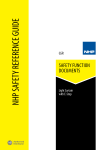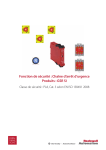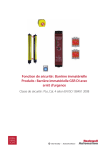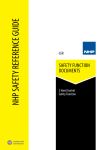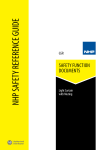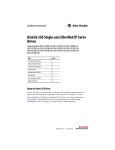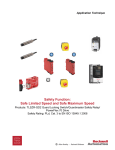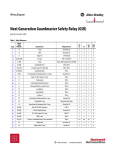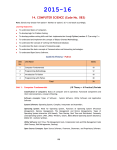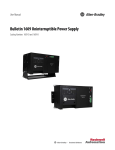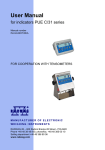Download Guard Door Locking Safety Function
Transcript
NHP SAFETY REFERENCE GUIDE GSR SAFETY FUNCTION DOCUMENTS Guard Door Locking Safety Function Safety Function Documents Door Locking and Monitoring Products: TLSZR-GD2 / Guardmaster® Safety Relays Safety Rating: PLe, Cat. 4 to EN ISO 13849.1 2008 Table of Contents: Introduction 6-30 Important User Information 6-30 Safety Function Realization 6-30 General Safety Information 6-31 Bill of Material 6-32 Electrical Schematic 6-33 Configuration 6-34 Calculation of the Performance Level 6-35 Verification and Validation Plan 6-39 Additional Resources 6-42 NHP Safety Reference Guide > Safety Function Documents: GSR 6B-31 Safety Function Documents Door Locking and Monitoring Products: TLSZR-GD2 / Guardmaster® Safety Relays Safety Rating: PLe, Cat. 4 to EN ISO 13849.1 2008 Introduction Safety Function Realization: Risk Assessment This Safety Function application note explains how to wire, configure, and integrate a GSR DI and EMD to monitor a TLSZRGD2 and prevent access while hazardous motion is present in the guarded area. An E-Stop safety function is also integrated into the safety system. The GSR DI monitors the TLSZR-GD2 and E-Stop to detect any faults in their operational state or faults in the circuits. The GSR DI and EMD monitor their internal circuits for any faults. Faults will not lead to the system performing its safety functions on demand, stopping the hazardous motion. The system cannot be reset once the safety function has been performed until the fault has been corrected. The performance level required is the result of a risk assessment and refers to the amount of the risk reduction to be carried out by the safety-related parts of the control system. Part of the risk reduction process is to determine the safety functions of the machine. For the purposes of this document the assumed required performance level (PLr), for each Safety Function is PLe, Category 4. A safety system that achieves PLe, Category 4, or higher, can be considered control reliable. Important User Information Solid state equipment has operational characteristics differing from those of electromechanical equipment. Safety Guidelines for the Application, Installation and Maintenance of Solid State Controls (publication SGI-1.1 available from your local Rockwell Automation® sales office or online at http://www. rockwellautomation.com/literature) describes some important differences between solid state equipment and hard-wired electromechanical devices. Because of this difference, and also because of the wide variety of uses for solid state equipment, all persons responsible for applying this equipment must satisfy themselves that each intended application of this equipment is acceptable. In no event will Rockwell Automation, Inc. be responsible or liable for indirect or consequential damages resulting from the use or application of this equipment. The examples and diagrams in this manual are included solely for illustrative purposes. Because of the many variables and requirements associated with any particular installation, Rockwell Automation, Inc. cannot assume responsibility or liability for actual use based on the examples and diagrams. No patent liability is assumed by Rockwell Automation, Inc. with respect to use of information, circuits, equipment, or software described in this manual. Reproduction of the contents of this manual, in whole or in part, without written permission of Rockwell Automation, Inc., is prohibited. Guard Locking Interlock Safety Function This application note includes two Safety Functions: 1.Prevention of access to hazardous motion in the guarded area. 2.Emergency stop of hazardous motion initiated by an E-Stop button. This system provides a Stop Category 0 stop; power is removed and the hazardous motion coasts to a stop. NHP Safety Reference Guide > Safety Function Documents: GSR 6B-32 Safety Function Documents Door Locking and Monitoring Products: TLSZR-GD2 / Guardmaster® Safety Relays Safety Rating: PLe, Cat. 4 to EN ISO 13849.1 2008 Safety Functional Requirements General Safety Information Access to hazardous motion is prevented by using an interlocked guard door with guard locking. Once motor power has been removed, the guard door will remain closed and locked for a predetermined amount time to confirm the hazardous motion is stopped. At such time, the operator is allowed to unlock the door by applying power to the guard lock using the key switch. While the door is open, it is monitored to prevent an unexpected start-up. Upon closing of the door, hazardous motion and power to the motor will not resume until a secondary action (start button depressed) occurs. Contact Rockwell Automation to find out more about our safety risk assessment services. Faults at the door interlock switch, wiring terminals or safety controller will be detected before the next safety demand. The stop time of the machine must be established such that the hazardous motion must be stopped before the user can reach the hazard. The safety function in this example is capable of connecting and interrupting power to motors rated up to 9A, 600VAC. The safety function will meet the requirements for Category 4, Performance Level “e” (Cat. 4, PLe), per ISO 13849-1, and SIL3 per IEC 62061, and control reliable operation per ANSI B11.19. Throughout this manual, when necessary, we use notes to make you aware of safety considerations. Functional Safety Description In this application example the access gate is locked during normal operation. The GSR DI uses pulse checking to monitor the E-Stop for actuation and faults. The TLSZR monitors itself for faults, lock status and gate actuation. When a fault is detected or the gate is unlocked or open the TLSZR turns off both its OSSD outputs. The GSR DI deenergizes the redundant safety contactors (K1 and K2) removing power to the hazardous motion upon actuation of the E-Stop or the TLSZR turning off its OSSD outputs. The hazardous motion coasts to a stop in a maximum of 20 seconds (Stop Category 0). The EMD delays power to the access gate release key switch while the hazardous motion is running in normal operation and for 30 seconds after power is removed from the hazardous motion in response to actuation of the E-Stop. Once power is provided to the gate release key switch via K1, K2 and K3 NC aux contacts, turning the key to the right energizes the solenoid unlocking the TLSZR-GD2 and the gate may be opened. The operator removes the key so that the gate cannot be locked nor the system reset with the operator in the hazardous area. The system cannot be reset until the gate is closed and locked by inserting the key and turning it to the left and the E-Stop is released. The Reset button must be pressed for more than a quarter second and less than three seconds. A shorter press will be ignored; a longer press will be ignored. NHP Safety Reference Guide > Safety Function Documents: GSR 6B-33 Safety Function Documents Door Locking and Monitoring Products: TLSZR-GD2 / Guardmaster® Safety Relays Safety Rating: PLe, Cat. 4 to EN ISO 13849.1 2008 Bill of Material Cat. No. System Overview Description Quantity 800F-1YP3 800F 1-Hole Enclosure E-Stop Station, Plastic, PG, Twist-to-Release 40mm, Non-Illuminated, 2 N.C. 1 440G-TZS21UPRH GuardLock, RFID Door Monitoring, Power to Release 1 800FM-G611MX10 800F Push Button - Metal, Guarded, Blue, R, Metal Latch Mount, 1 N.O. Contact(s) - Reset 1 800FM-KM22MX11 800F 2 position Key Selector Switch, Right Key Removal, 1 N.O., 1 N.C. - Gate Release 1 440R-D22R2 Guardmaster Safety Relay, 2 Dual Channel Universal Inputs, 1 N.C. Solid State Auxiliary Outputs 1 440R-EM4R2D Guardmaster Safety Relay, Expansion Module (Single Wire Safe is only input), N/A Auxiliary Outputs 1 100S-C09ZJ23C MCS 100S-C Safety Contactor, 9A, 24V DC 2 700-HPS2Z24 700-HPS Safety Relay, DPDT, 8A, 24V DC - K3 & K4 2 700-HN123 Socket, DIN mount - K3 & K4 2 700-HN119 Retainer Clip - K3 & K4 2 855EP-G24Y3L5 Control Tower Stack Light, Pre-Assembled, 10 cm Pole Mount with Cap, Gray Housing, 24V AC/DC Full Voltage, Green Steady LED, Amber Flashing Light 1 Setup and Wiring For detailed information on installing and wiring, refer to the product manuals listed in the Additional Resources. The GSR DI monitors the E-Stop by running its S11 and S21 pulsed outputs through the two channels of the E-Stop to inputs S12 and S22 respectively. A loose wire, a shorted contact, a short to 24V, a short to 0V or a cross fault between the channels will be detected by the DI. The TLSZR is a fully self monitoring device. When faults are detected the TLSZR responds by turning off both its OSSD outputs. The GSR DI monitoring both the E-Stop and the TLSZR outputs responds to any faults or demands from the devices by deenergizing its safety contacts removing power from the coils of the redundant 100S safety contactors (K1 and K2). At the same time, via the Single Wire Safety (SWS) connection, the GSR DI starts the EMD 30 second delay off function. The hazardous motion coasts to a stop in no more than 20 seconds. After the 30 second delay the EMD de-energizes it safety contacts removing power from the coil of interposing relays K3 and K4. With K1, K2, K3 and K4 de-energized 24V is available at the gate release key switch. Turning the key switch to the right energizes the solenoid of the TLSZR unlocking the gate. The key can be removed when in the “right” position. Once the key is removed the gate cannot be locked nor the system reset. The gate must be closed, the key inserted and turned to the left locking the gate before the reset button will function. The key cannot be removed when in the “Left” position. In this example the hazardous motion has ceased before access to the guarded area can occur. In essence there is no danger. NHP Safety Reference Guide > Safety Function Documents: GSR 6B-34 Safety Function Documents Door Locking and Monitoring Products: TLSZR-GD2 / Guardmaster® Safety Relays Safety Rating: PLe, Cat. 4 to EN ISO 13849.1 2008 Electrical Schematic NHP Safety Reference Guide > Safety Function Documents: GSR 6B-35 Safety Function Documents Door Locking and Monitoring Products: TLSZR-GD2 / Guardmaster® Safety Relays Safety Rating: PLe, Cat. 4 to EN ISO 13849.1 2008 Configuration NHP Safety Reference Guide > Safety Function Documents: GSR 6B-36 Safety Function Documents Door Locking and Monitoring Products: TLSZR-GD2 / Guardmaster® Safety Relays Safety Rating: PLe, Cat. 4 to EN ISO 13849.1 2008 Calculation of the Performance Level When configured and installed properly, the two Safety Functions of this safety system, prevention of access to hazardous motion in the guarded area and emergency stop of hazardous motion initiated by an E-Stop button, can achieve a safety rating of PLe, Cat. 4 according to EN ISO 13849.1 2008. As calculated using the SISTEMA tool. Door Monitoring and Locking Project Prevention of access to hazardous motion in the guarded area Safety Function. Emergency stop of hazardous motion initiated by an E-Stop button Safety Function. NHP Safety Reference Guide > Safety Function Documents: GSR 6B-37 Safety Function Documents Door Locking and Monitoring Products: TLSZR-GD2 / Guardmaster® Safety Relays Safety Rating: PLe, Cat. 4 to EN ISO 13849.1 2008 Calculation of the Performance Level cont The prevention of access to hazardous motion in the guarded area Safety Function can be modeled as below. The Function Safety data for the E-Stop Input subsystem is: The Functional Safety data for the GSR DI Logic subsystem is: NHP Safety Reference Guide > Safety Function Documents: GSR 6B-38 Safety Function Documents Door Locking and Monitoring Products: TLSZR-GD2 / Guardmaster® Safety Relays Safety Rating: PLe, Cat. 4 to EN ISO 13849.1 2008 Calculation of the Performance Level cont The Functional Safety data for the EMD Logic subsystem is: The Functional safety data for the 100S Output subsystem is: The Functional Safety data for the 700HPS Output subsystem is NHP Safety Reference Guide > Safety Function Documents: GSR 6B-39 Safety Function Documents Door Locking and Monitoring Products: TLSZR-GD2 / Guardmaster® Safety Relays Safety Rating: PLe, Cat. 4 to EN ISO 13849.1 2008 Calculation of the Performance Level cont Emergency stop of hazardous motion initiated by an E-Stop button Safety Function can be modeled as below. The Functional Safety data for the E-Stop Input subsystem is: The Functional safety data for the GSR DI Logic subsystem is: NHP Safety Reference Guide > Safety Function Documents: GSR 6B-40 Safety Function Documents Door Locking and Monitoring Products: TLSZR-GD2 / Guardmaster® Safety Relays Safety Rating: PLe, Cat. 4 to EN ISO 13849.1 2008 Calculation of the Performance Level cont The Functional Safety data for the 100S Output subsystem is: Note that the E-Stop, 100S contactor and 700HPS relay data includes MTTFd, DCavg, and CCF data. This is because these are electromechanical devices. Electromechanical devices functional safety evaluations include how frequently they are operated, whether they are effectively monitored for faults and properly specified and installed. Verification and Validation Plan SISTEMA calculates the MTTFd using B10d data provided for the contactors along with the estimated frequency of use entered during the creation of the SISTEMA project. This application example presumes that the E-Stop is operated or tested once per day or 365 times a year. Verification is an analysis of the resulting safety control system. The Performance Level (PL) of the safety control system is calculated to confirm it meets the Required Performance Level (PLr) specified. The SISTEMA software tool is typically utilized to perform the calculations and assist with satisfying the requirements of ISO 13849-1. The DCavg (99%) for the contactors was selected from the Output Device table of EN ISO 13849-1 Annex E. “Direct Monitoring”. The DCavg (99%) for the E-Stop was selected from the Input Device table of EN ISO 13849-1 Annex E. “Cross Monitoring”. The (CCF) value is generated using the scoring process outlined in Annex F of ISO 13849-1. The complete CCF scoring process must be done when actually implementing an application. A minimum score of 65 points must be achieved. A CCF of 65 was entered for practical purposes in each case for this application example. Verification and Validation play an important role in the avoidance of faults throughout the safety system design and development process. ISO/EN 13849-2 sets the requirements for verification and validation. It calls for a documented plan to confirm all the Safety Functional Requirements have been met. Validation is a functional test of the safety control system to demonstrate that it meets the specified requirements of the safety function. The safety control system is tested to confirm all of the safety related outputs respond appropriately to their corresponding safety related inputs. The functional test should include normal operating conditions in addition to potential fault inject of failure modes. A checklist is typically used to document the validation of the safety control system. Prior to validating the GSR Safety Relay system, it is necessary to confirm the GSR Relay has been wired and configured in accordance with the Installation Instructions. NHP Safety Reference Guide > Safety Function Documents: GSR 6B-41 Safety Function Documents Door Locking and Monitoring Products: TLSZR-GD2 / Guardmaster® Safety Relays Safety Rating: PLe, Cat. 4 to EN ISO 13849.1 2008 GSR Door Monitoring Safety Function Verification and Validation Checklist GENERAL MACHINERY INFORMATION Machine Name / Model Number Machine Serial Number Customer Name Test Date Tester Name(s) Schematic Drawing Number Guardmaster Safety Relay Model Safety Wiring and Relay Configuration Verification Test Step Verification Pass/Fail Changes/Modifications Visually inspect the safety relay circuit is wired as documented in the schematics. Visually inspect the safety relay rotary switch settings are correct as documented. Normal Operation Verification - The safety relay system properly responds to all normal Start, Stop, Estop and Reset Commands Test Step Verification Pass/Fail Changes/Modifications Initiate a Start Command. Both contactors should energize for a normal machine run condition. Verify proper machine status indication and safety relay LED indication. Initiate a Stop Command. Both contactors should de-energize for a normal machine Stop condition. Verify proper machine status indication and safety relay LED indication. While Running, open the monitored guard door. Both contactors should de-energize and open for a normal safe condition. Verify proper machine status indication and safety relay LED indication. Repeat for all guard doors. While Stopped, with the guard door open, initiate a Start Command. Both contactors should remain de-energized and open for a normal safe condition. Verify proper machine status indication and safety relay LED indication. Repeat for all door locks. Initiate Reset Command. Both contactors should remain de-energized. Verify proper machine status indication and safety relay LED indication. Abnormal Operation Verification - The Safety Relay system properly responds to all foreseeable faults with corresponding diagnostics. Door Monitoring Input Tests Test Step Validation Pass/Fail Changes/Modifications Pass/Fail Changes/Modifications Pass/Fail Changes/Modifications While Running, remove the Channel 1 wire from the safety relay. Both contactors should de-energize. Verify proper machine status indication and safety relay LED indication. Repeat for Channel 2. While Running, short the Channel 1 of the safety relay to +24VDC. Both contactors should de-energize. Verify proper machine status indication and safety relay LED indication. Repeat for Channel 2. While Running, short the Channel 1 of the safety relay to (-) 0VDC. Both contactors should de-energize. Verify proper machine status indication and safety relay LED indication. Repeat for Channel 2. While Running, short Channels 1 & 2 of the safety relay. Both contactors should de-energize. Verify proper machine status indication and safety relay LED indication. GSR Logic Solver Tests Test Step Validation While Running, remove the single wire safety connection between two adjoining safety relays in the system. All contactors should de-energize. Verify proper machine status indication and safety relay LED indication. Repeat for all safety connections. This test is not applicable for single relay circuits. While Running, turn the logic rotary switch on the safety relay. All contactors should remain de-energized. Verify proper machine status indication and safety relay LED indication. Repeat for all safety relays in the system. Safety Contactor Output Tests Test Step Validation While Running, remove the contactor feedback from the safety relay. All contactors should remain energized. Initiate a Stop Command followed by a Reset Command. The relay should not restart or reset. Verify proper machine status indication and safety relay LED indication. NHP Safety Reference Guide > Safety Function Documents: GSR 6B-42 Safety Function Documents Door Locking and Monitoring Products: TLSZR-GD2 / Guardmaster® Safety Relays Safety Rating: PLe, Cat. 4 to EN ISO 13849.1 2008 GSR Door Monitoring Safety Function Verification and Validation Checklist cont GENERAL MACHINERY INFORMATION Machine Name / Model Number Machine Serial Number Customer Name Test Date Tester Name(s) Schematic Drawing Number Guardmaster Safety Relay Model Safety Wiring and Relay Configuration Verification Test Step Verification Pass/Fail Changes/Modifications Visually inspect the safety relay circuit is wired as documented in the schematics. Visually inspect the safety relay rotary switch settings are correct as documented. Normal Operation Verification - The safety relay system properly responds to all normal Start, Stop, Estop and Reset Commands Test Step Verification Pass/Fail Changes/Modifications Initiate a Start Command. Both contactors should energize for a normal machine run condition. Verify proper machine status indication and safety relay LED indication. Initiate a Stop Command. Both contactors should de-energize for a normal machine Stop condition. Verify proper machine status indication and safety relay LED indication. While Running, press the E-Stop pushbutton. Both contactors should de-energize and open for a normal safe condition. Verify proper machine status indication and safety relay LED indication. Repeat for all E-Stop pushbuttons. While Stopped, press the E-Stop pushbutton, initiate a Start Command. Both contactors should remain de-energized and open for a normal safe condition. Verify proper machine status indication and safety relay LED indication. Repeat for all E-Stop pushbuttons. Initiate Reset Command. Both contactors should remain de-energized. Verify proper machine status indication and safety relay LED indication. Abnormal Operation Verification - The Safety Relay system properly responds to all foreseeable faults with corresponding diagnostics. E-Stop Input Tests Test Step Validation Pass/Fail Changes/Modifications Pass/Fail Changes/Modifications Pass/Fail Changes/Modifications While Running, remove the Channel 1 wire from the safety relay. Both contactors should de-energize. Verify proper machine status indication and safety relay LED indication. Repeat for Channel 2. While Running, short the Channel 1 of the safety relay to +24VDC. Both contactors should de-energize. Verify proper machine status indication and safety relay LED indication. Repeat for Channel 2. While Running, short the Channel 1 of the safety relay to (-) 0VDC. Both contactors should de-energize. Verify proper machine status indication and safety relay LED indication. Repeat for Channel 2. While Running, short Channels 1 & 2 of the safety relay. Both contactors should de-energize. Verify proper machine status indication and safety relay LED indication. GSR Logic Solver Tests Test Step Validation While Running, remove the single wire safety connection between two adjoining safety relays in the system. All contactors should de-energize. Verify proper machine status indication and safety relay LED indication. Repeat for all safety connections. This test is not applicable for single relay circuits. While Running, turn the logic rotary switch on the safety relay. All contactors should remain. de-energized. Verify proper machine status indication and safety relay LED indication. Repeat for all safety relays in the system. Safety Contactor Output Tests Test Step Validation While Running, remove the contactor feedback from the safety relay. All contactors should remain energized. Initiate a Stop Command followed by a Reset Command. The relay should not restart or reset. Verify proper machine status indication and safety relay LED indication. NHP Safety Reference Guide > Safety Function Documents: GSR 6B-43 Safety Function Documents Door Locking and Monitoring Products: TLSZR-GD2 / Guardmaster® Safety Relays Safety Rating: PLe, Cat. 4 to EN ISO 13849.1 2008 Additional Resources For more information about the products used in this example refer to these resources. Document Pub. No. Description Guard Locking Switch Installation Instructions 440G-IN007 How to install, commission, operate and maintain the 440G-TZS21UPRH Guardmaster Safety Relay Installation Instructions 10000175129 How to install, commission, operate and maintain the 440R-D22R2 Safety Relays Guardmaster Safety Relay Troubleshooting Guide 440R-TG002 How to troubleshoot the 440RD22R2 Safety Relays Guardmaster Expansion Relay Installation Instructions 440R-IN045 How to install, commission, operate and maintain the 440R-EM4R2D Expansion Relay Guardmaster Expansion Relay Troubleshooting Guide 440R-TG001 How to install, commission, operate and maintain the 440R-EM4R2D Expansion Relay Safety Products Catalog S117-CA001A Overview of Safety products, product specifications, and application examples GuardShield Type 4 User Manual 440L-UM003 How to install, operate, and maintain the 440L Safety Light Curtains Next Generation Guardmaster Safety Relays SAFETY-WD001 Functional descriptions, guidance, and wiring for Safety Relays Heavy Duty Guard Interlock Switch Installation Instructions 440K-IN008 How to install, configure, commission, operate, and maintain MT-GD2 Interlock Switches Trojan T15 Interlock Switch Installation Instructions 440K-IN003 How to install, configure, commission, operate, and maintain Trojan T15 Interlock Switches Safety Interlock Switches Brochure EUSAFE-BR001 Overview of Interlock Switches Guardmaster Safety Relay SI Installation Instructions 440R-IN042 How to install, configure, commission, operate, and maintain GSR SI Safety Relays Guardmaster Safety Relays Selection Guide 440R-SG001 Overview of Guardmaster Safety Relays RightSight Photoelectric Sensor Installation Instructions 42EF-IN003 How to install, commission, operate, and maintain 42EF Photoelectric Sensors MSR42 Control Module User Manual 440R-UM008 How to install, commission, operate, and maintain MSR42 Systems MSR45E Safety Relay Expansion Module User Manual 440R-UM007 How to install, commission, operate, and maintain the MSR45E Expansion Module SensaGuard Integrated Latch Unique Coded Installation Instructions 440N-IN011 How to install, commission, operate, and maintain the SensaGuard Touch Button and Guard Installation Instructions Zero-Force Touch Buttons Family Brochure MSR12T Safety Relays Installation Instructions Guardmaster Safety Relay Installation Instructions 800Z-IN001-MU 800Z-BR002 MINOTR-IN010 440R-IN042 How to install and mount the 800Z Touch Button Brochure that describes all 800Z Palm Buttons How to install, configure, commission, operate, and maintain the MSR 12T Safety Relays How to install, commission, operate and maintain the 440R-S12R2 Safety Relays NHP Safety Reference Guide > Safety Function Documents: GSR 6B-44 Safety Function Document Disclaimer The information contained in this and any related publications is intended as a guide only. Every care has been taken to ensure that the information given is accurate at time of publication. Neither NHP nor any of the manufacturers portrayed in this and any related publications accept responsibility for any errors or omissions contained therein nor any misapplications resulting from such errors or omissions. Risk assessments should be conducted by authorized persons. The purchaser and installer are responsible for ensuring the safety system(s) incorporating these products complies with all current regulations and applicable standards. Products are subject to change without notice and may differ from any illustration(s) provided. All products offered for sale are subject to NHP standard Conditions of Sale, a copy of which is available on application. NHP Safety Reference Guide > Safety Function Documents: GSR 6B-45


















